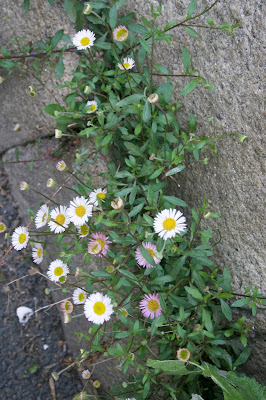Michaelmas daisy Aster amellus, copyright Hectonichus.
Belongs within: Astereae.
Aster is a Holarctic genus of composite-flowered herbs. Members include the Michaelmas daisy
Aster amellus, a perennial species most commonly found in calcareous, rocky soils that has become widely grown as an ornamental.
Characters (from Hickman 1993): Annual or perennial from caudex or rhizome. Stem generally erect, 1–20 dm. Leaves basal, cauline, or both, alternate, generally entire; basally generally petioled. Inflorescence with heads generally radiate, solitary or in a cyme or panicle; involucre obconic to hemispheric; phyllaries in 2–6 series, outer generally smaller than inner, free, at least inner with pale, papery margins; receptacle more or less flat, naked. Ray florets 0–many; corolla violet to pink or white. Disk florets many; corolla and anthers generally yellow, tube generally narrower than throat; anther tips more or less triangular; style branches flat on inner face, base more or less warty, tip acute, hairy. Fruit generally rounded, more or less ribbed, more or less brown; pappus of bristles, white to brownish.
<==Aster
|--*A. amellus Linnaeus 1753 P01, CD07
|--A. abbreviatus C55
|--A. ageratoides MH98
|--A. albescens O88
|--A. alpigenus H93
| |--A. a. var. alpigenus H93
| `--A. a. var. andersonii H93
|--A. alpinus H09
|--A. altaicus O88
|--A. ascendens [=A. adscendens] H93
|--A. asteroides O88
|--A. barbellatus O88
|--A. bellidiflorus C55
|--A. bernardinus H93
|--A. breweri [=Chrysopsis breweri] H93
|--A. brickellioides H93
|--A. brumalis C55
|--A. campestris H93
|--A. canescens S72
|--A. chilensis H93
|--A. chinensis R00
|--A. concinnatus C55
|--A. diplostephioides O88
|--A. dumosus C55
|--A. eatonii H93
|--A. engelmannii H93
|--A. falconeri O88
| |--A. f. ssp. falconeri O88
| `--A. f. ssp. nepalensis O88
|--A. flaccidus O88
|--A. foliaceus H93
| |--A. f. var. foliaceus H93
| |--A. f. var. lyallii H93
| `--A. f. var. parryi [incl. A. foliaceus var. apricus] H93
|--A. frondosus H93
|--A. greatae [=A. greatai] H93
|--A. heliopsis O88
|--A. himalaicus O88
|--A. imbricatus C06
|--A. indamellus O88
|--A. integrifolius H93
|--A. laevigatus C55
|--A. laevis C55
|--A. lanceolatus V09
| |--A. l. ssp. lanceolatus H93
| `--A. l. ssp. hesperius H93
|--A. ledophyllus H93
|--A. lentus [=A. chilensis var. lentus; incl. A. chilensis var. sonomensis] H93
|--A. leucanthemus C55
|--A. mutabilis C55
|--A. novae-angliae MS98
|--A. novi-belgii C55
|--A. occidentalis H93
| |--A. o. var. occidentalis [incl. A. o. var. delectabilis, A. o. var. intermedius, A. o. var. parishii] H93
| `--A. o. var. yosemitanus [incl. A. paludicola] H93
|--A. oregonensis [incl. A. oregonensis ssp. californicus] H93
|--A. parviflorus C55
|--A. pauciflorus H93
|--A. peirsonii H93
|--A. radulinus H93
|--A. rubricaulis C55
|--A. salicifolius C55
|--A. scopulorum H93
|--A. squamatus Y98
|--A. stracheyi O88
|--A. subulatus BR65
| |--A. s. var. subulatus H93
| `--A. s. var. ligulatus H93
|--A. tanacetifolius BT72
|--A. tricephalus O88
|--A. tripolium CS77
`--A. versicolor C55
*Type species of generic name indicated
REFERENCES
[BT72] Baker, E. W., & D. M. Tuttle. 1972. New species and further notes on the Tetranychoidea mostly from the southwestern United States (Acarina: Tetranychidae and Tenuipalpidae).
Smithsonian Contributions to Zoology 116: 1–37.
[BR65] Black, J. M., & E. L. Robertson. 1965.
Flora of South Australia. Part IV. Oleaceae–Compositae. W. L. Hawes, Government Printer: Adelaide.
[C55] Candolle, A. de. 1855.
Géographie Botanique Raisonée: Ou exposition des faits principaux et des lois concernant la distribution géographique des plantes de l’époque actuelle vol. 2. Librairie de Victor Masson: Paris.
[CD07] Cantino, P. D., J. A. Doyle, S. W. Graham, W. S. Judd, R. G. Olmstead, D. E. Soltis, P. S. Soltis & M. J. Donoghue. 2007. Towards a phylogenetic nomenclature of Tracheophyta.
Taxon 56 (3): E1–E44.
[C06] Cheeseman, T. F. 1906.
Manual of the New Zealand Flora. John Mackay, Government Printer: Wellington.
[CS77] Cramp, S., & K. E. L. Simmons (eds) 1977.
Handbook of the Birds of Europe, the Middle East and North Africa: The Birds of the Western Palaearctic vol. 1.
Ostrich to Ducks. Oxford University Press: Oxford.
[H09] Heltmann, H. 2009. Der Königstein (Piatra Craiului), die Perle der Burzenländer Gebirge.
Mauritiana 20 (3): 515–527.
[H93] Hickman, J. C. (ed.) 1993.
The Jepson Manual: Higher Plants of California. University of California Press: Berkeley (California).
[MS98] Margulis, L., & K. V. Schwartz. 1998.
Five Kingdoms: An Illustrated Guide to the Phyla of Life on Earth 3
rd ed. W. H. Freeman and Company: New York.
[MH98] Morikawa, H., A. Higaki, M. Nohno, M. Takahashi, M. Kamada, M. Nakata, G. Toyohara, Y. Okamura, K. Matsui, S. Kitani, K. Fujita, K. Irifune & N. Goshima. 1998. More than a 600-fold variation in nitrogen dioxide assimilation among 217 plant taxa.
Plant, Cell and Environment 21: 180–190.
[O88] Ohba, H. 1988. The alpine flora of the Nepal Himalayas: an introductory note.
In: Ohba, H., & S. B. Malla (eds)
The Himalayan Plants vol. 1.
The University Museum, University of Tokyo, Bulletin 31: 19–46.
[P01] Pennisi, E. 2001. Linnaeus’s last stand?
Science 291: 2304–2307.
[R00] Ramond, C. 1800. Suite des plantes inédites des Hautes-Pyrénées.
Bulletin des Sciences, par la Societé Philomathique de Paris 2 (42): 140–141.
[S72] Shields, O. 1972. Flower visitation records for butterflies (Lepidoptera).
Pan-Pacific Entomologist 48 (3): 189–203.
[V09] Verdcourt, B. (ed.) 2009. Additions to the Wild Fauna and Flora of the Royal Botanic Gardens, Kew. XXVI. Miscellaneous records.
Kew Bulletin 64 (1): 183–194.
[Y98] Yannitsaros, A. 1998. Additions to the flora of Kithira (Greece) I.
Willdenowia 28: 77–94.
Last updated: 30 December 2021.










